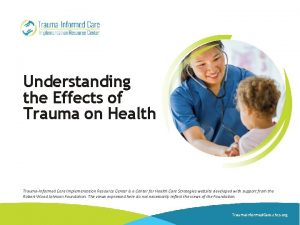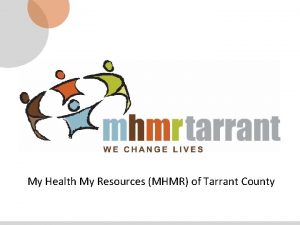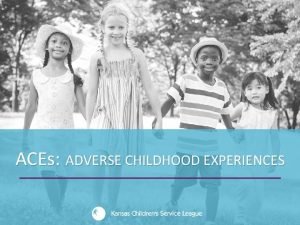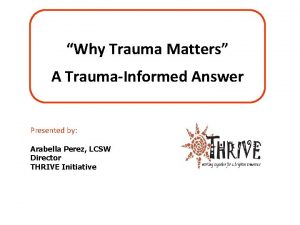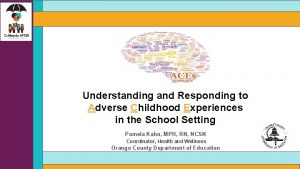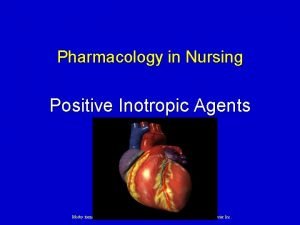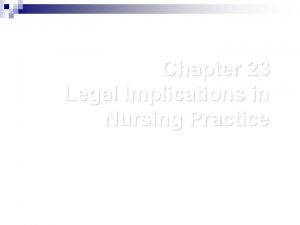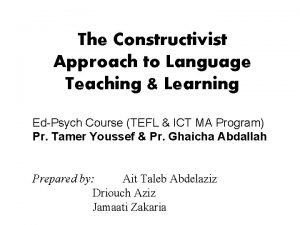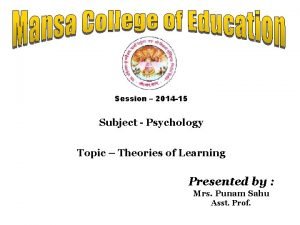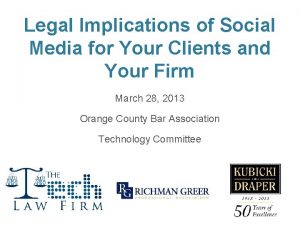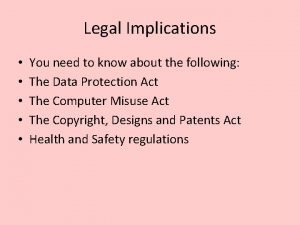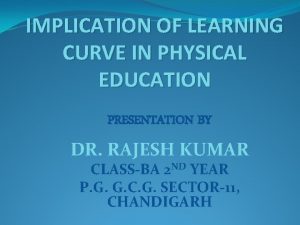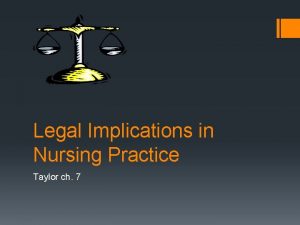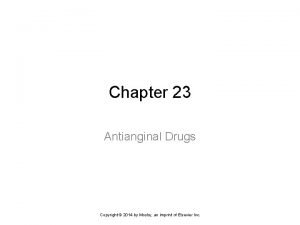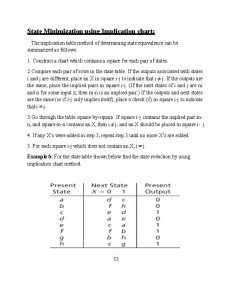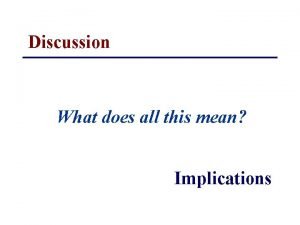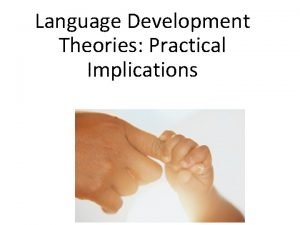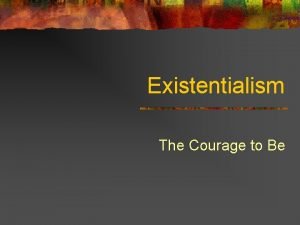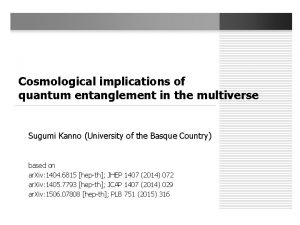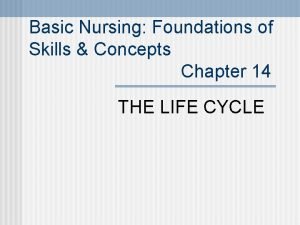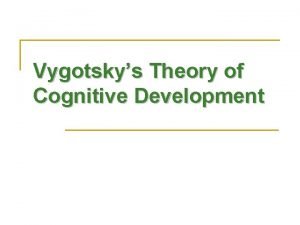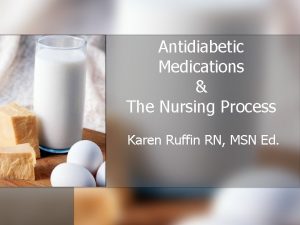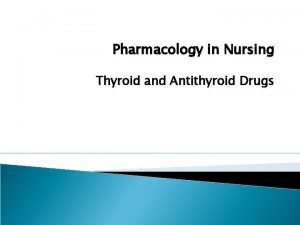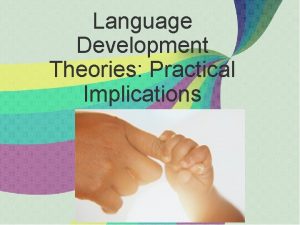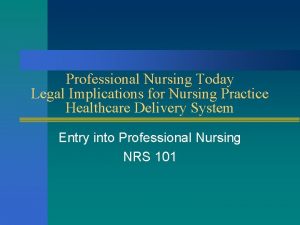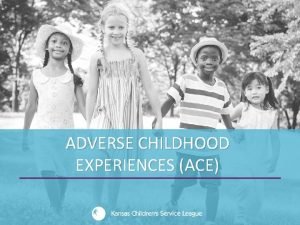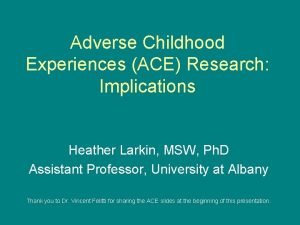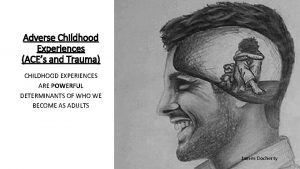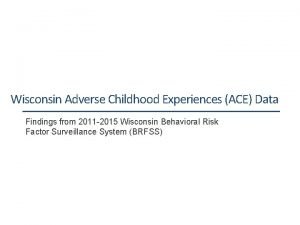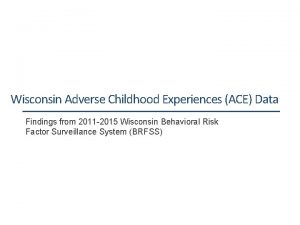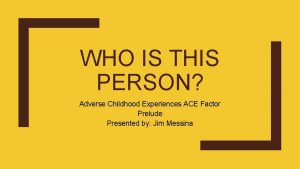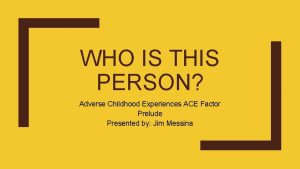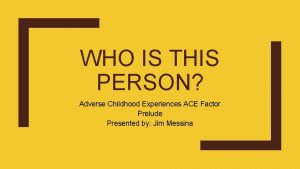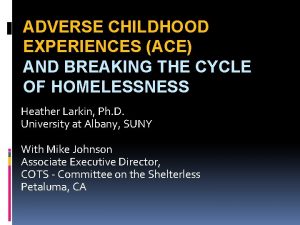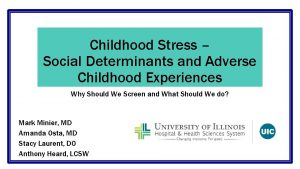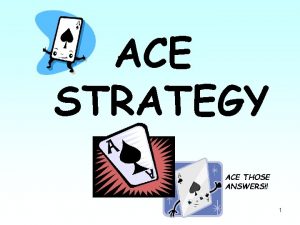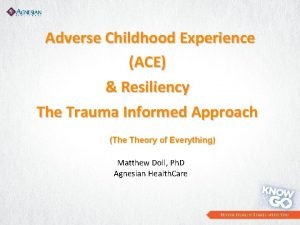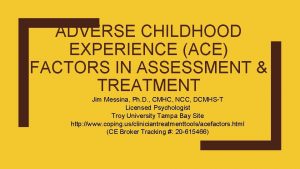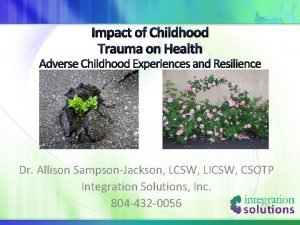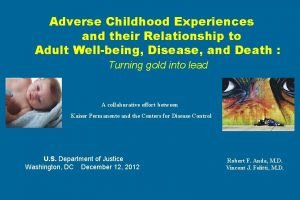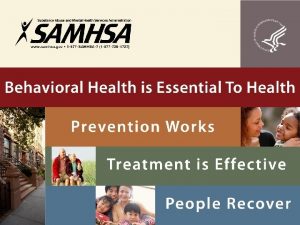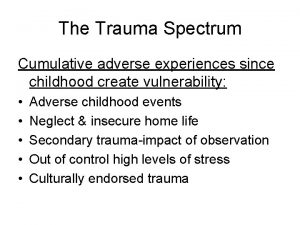ADVERSE CHILDHOOD EXPERIENCES ACE IMPLICATIONS FOR THE CLASSROOM

































- Slides: 33

ADVERSE CHILDHOOD EXPERIENCE’S (ACE) IMPLICATIONS FOR THE CLASSROOM Adapted from: Stewart, Altha J. University of Tennessee Health Science Center. March 7, 2016

Agenda 1. Introduction Objective: Participants will: Learn the impact of trauma on the brain and the implications that it has in the classroom Discuss trauma-sensitive practices and procedures Take the Ace Assessment ACE – How it impacts your Health ACE – How it impacts learning What does a trauma sensitive school/classroom look like Resilience Adverse childhood experiences (ACEs) of abuse, neglect and family dysfunction between birth and age 18 can disrupt brain development and limit social, emotional and cognitive functioning. ACEs are the root cause of many serious academic, social and behavioral problems that have the potential to prevent a child from receiving the full benefits of education

SHARE WITH A NEIGHBOR WHAT TYPES OF TRAUMA, HAVE YOUR STUDENTS EXPERIENCED. TO WHAT EXTENT DOES IT AFFECT THEIR LEARNING?

TAKE THE ACE’S ASSESSMENT

ACE’S FINDINGS • ACEs are surprisingly common • ACEs still have profound effect 50 years later • Transformed from psychosocial experience into physical diseases, social dysfunction and mental illness • ACEs are the main determinant of the health and social well-being of the nation.

Adapted from Childrens Trust of South Carolina. https: //scchildren. org/prevention_learning_center/adverse_childhood_experiences_aces/

Adapted from Childrens Trust of South Carolina. https: //scchildren. org/prevention_learning_center/adverse_childhood_experiences_aces/


Adapted from Childrens Trust of South Carolina. https: //scchildren. org/prevention_learning_center/adverse_childhood_experiences_aces/


Adapted from Childrens Trust of South Carolina. https: //scchildren. org/prevention_learning_center/adverse_childhood_experiences_aces/


SHARE WITH A NEIGHBOR HOW DOES ACE’S IMPACT YOUR FAMILY & COMMUNITY IS THERE ANYTHING YOU CAN DO ABOUT IT.

IMPACT ON CHILD DEVELOPMENT • • The ability to form healthy relationships is highly dependent on learned social skills Children’s social skill learning is directly related to the characteristics of their environments • Violence teaches withdrawal, anxiety, distrust, over-reaction and/or aggression as coping behaviors • Disordered environments=dysfunctional skills

CHILDREN & TRAUMATIC EVENTS Ø Over half the children in the US are exposed to violence, crime and abuse every year Ø 26% will witness or experience a traumatic event before the age of 4 Ø Exposure to violence in any form harms children and can have many negative effects throughout childhood and into adulthood. Ø We spend over $100 billion on problems related childhood abuse and trauma (physical, emotional, legal, etc. )

TRAUMA • Trauma does not automatically cause PTSD (25% risk), violation/degradation/betrayal increases risk to 50 -75+% • Trauma is Epidemic in 60% of Adults and 50% of Children • Trauma is almost universal for boys (93%) and girls (87%) in the JJ System • Trauma increases the risk of further trauma (most survivors have at least 2 distinct trauma Life with Trauma. Retrieved from: https: //www. steampoweredfamily. com/brains/life-with-trauma/

TRAUMA By adolescence, children have sufficient skill and independence to seek relief through the following: Drinking alcohol Smoking tobacco Sexual promiscuity Using psychoactive materials Overeating/eating disorders Delinquent behavior

Adapted from Childrens Trust of South Carolina. https: //scchildren. org/prevention_learning_center/adverse_childhood_experiences_aces/

Adapted from Childrens Trust of South Carolina. https: //scchildren. org/prevention_learning_center/adverse_childhood_experiences_aces/

Adapted from Childrens Trust of South Carolina. https: //scchildren. org/prevention_learning_center/adverse_childhood_experiences_aces/


Five Most Frequent Types of Childhood Trauma Experiences (Reported By Caregivers) 50% 42% 42% Separated from caregiver(s) Emotional abuse Sexual abuse 40% 30% 25% 20% 10% 0% Bad accident Witnessed domestic violence Adapted from Childrens Trust of South Carolina. https: //scchildren. org/prevention_learning_center/adverse_childhood_experiences_aces/

TRAUMATIZED CHILDREN § World is punitive, judgmental, humiliating and blaming § Control is external, not internalized § People are unpredictable and untrustworthy § Defend themselves above all else § Believe that admitting mistakes is worse than telling truth

Prevalence of indicators of negative well-being, by number of adverse childhood experience (12 -17) Measure of well being 0 ACEs 1 ACEs 2 ACEs 3+ ACEs High externalizing behavior 18% 26% 33% 41% Low engagement in school 25% 33% 44% 48% Household contacted due to problems at school 13% 23% 31% 38% Grade repetition 6% 12% 14% 21% Does not stay calm and controlled 24% 34% 40% 44% Does not finish tasks started 27% 36% 44% 49% Diagnosed with a learning disability 9% 13% 16% 23% Fair or poor physical health 2% 4% 4% 6% Adapted from Childrens Trust of South Carolina. https: //scchildren. org/prevention_learning_center/adverse_childhood_experiences_aces/



SHARE WITH A NEIGHBOR HOW DOES THIS INFORMATION CHANGE HOW YOU WILL VIEW YOUR STUDENTS?

WHAT DOES A TRAUMA INFORMED CLASSROOM/SCHOOL LOOK LIKE? Shifts in mindsets (e. g. moving away from reactive to more proactive approaches or moving away from punitive disciplinary approaches toward teaching social and self-regulation skill building) Moving toward problem-solving more quickly after identifying a concern Increase in trauma-sensitive problem-solving (e. g. increased curiosity and discussion about the underlying causes of challenging behavior) Teachers sharing effective strategies with one another more frequently Improvements in collaborations among school staff (increased teamwork) It is important to note that most schools collect a wide range of quantitative data and the existing data can be used. It not necessary to generate new quantitative measures. Examples include: Staff and student surveys Decreases in crisis calls Decreases in numbers of office referrals for punitive disciplinary reasons Reductions in chronic attendance issues/ improvements in attendance Decreases in reports of bullying

Adapted from Childrens Trust of South Carolina. https: //scchildren. org/prevention_learning_center/adverse_childhood_experiences_aces/

PROTECTIVE FACTORS RESILIENCE ØStrengths-based approach to supporting children that incorporates natural supports (“the village”), services (“treatment, support, advocacy”), and skills building related to self-advocacy, education and empowerment ØWork from a “needs” base, not a problem (“deficit”) focus



https: //www. cdc. gov/violenceprevention/acestudy/index. html https: //www. npr. org/sections/health-shots/2015/03/02/387007941/take-the-ace-quiz-and-learn-what-it-does-and-doesnt-mean https: //www. childtrends. org/publications/prevalence-adverse-childhood-experiences-nationally-state-race-ethnicity Murphey, David. The prevalence of adverse childhood experiences, nationally, by state, and by race or ethnicity. Retrieved from: https: //www. childtrends. org/staff/david-murphey-2 Strompolis, Melissa. South Carolina Adverse Childhood Experiences Initiative. www. scchildren. org/aces. July 10, 2017. Retrieved from: https: //scchildren. org/research/adverse-childhood-experiences/
 Adverse childhood experiences study
Adverse childhood experiences study Adverse childhood experiences study
Adverse childhood experiences study Adverse childhood experiences study
Adverse childhood experiences study Adverse childhood experiences study
Adverse childhood experiences study Slidetodoc.com
Slidetodoc.com Middle childhood
Middle childhood Btech smart classes
Btech smart classes Dromotropic effect
Dromotropic effect Legal implications of nursing documentation
Legal implications of nursing documentation Constructivism teaching
Constructivism teaching Pavlov theory of learning
Pavlov theory of learning Legal implications of social media
Legal implications of social media Antifungal mechanism of action
Antifungal mechanism of action Eng2d media unit
Eng2d media unit What are legal implications
What are legal implications Learning curve in physical education
Learning curve in physical education Consumer behavior cengage
Consumer behavior cengage Legal implications of nursing documentation
Legal implications of nursing documentation Ranexa nursing implications
Ranexa nursing implications Implication table method
Implication table method Discussion and implications
Discussion and implications Implications of nativist theory
Implications of nativist theory Marketing implications
Marketing implications Nietzsche existentialism
Nietzsche existentialism Implications of quantum entanglement
Implications of quantum entanglement Nursing implications
Nursing implications Future implications definition
Future implications definition Vygotsky guided participation example
Vygotsky guided participation example Humalog nursing implications
Humalog nursing implications Nursing implications for synthroid
Nursing implications for synthroid Language
Language Example of proposition in math
Example of proposition in math What is tautology in math
What is tautology in math Trends and issues in nursing
Trends and issues in nursing
